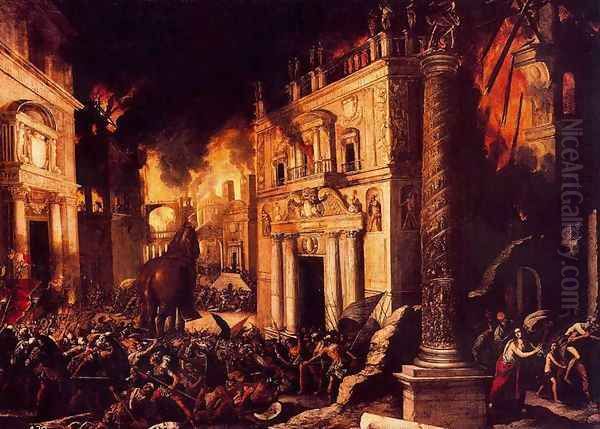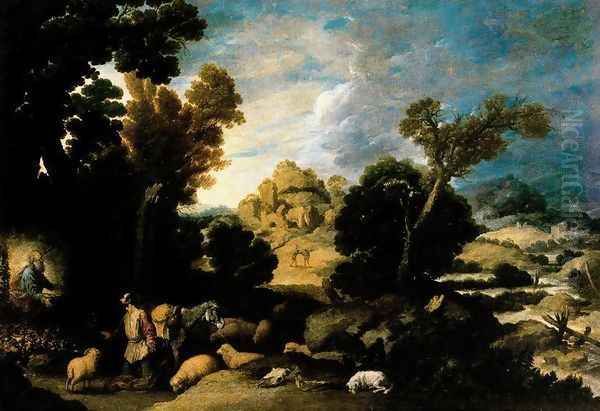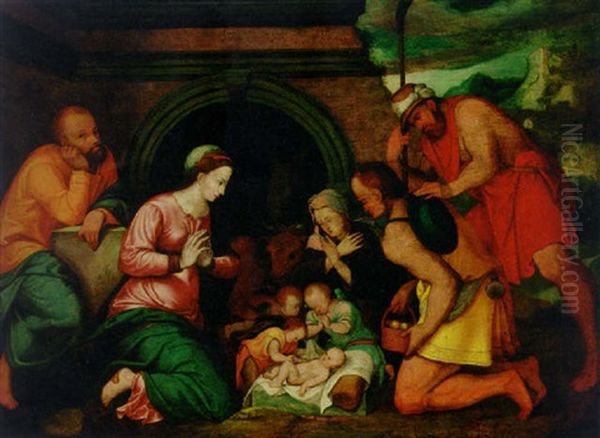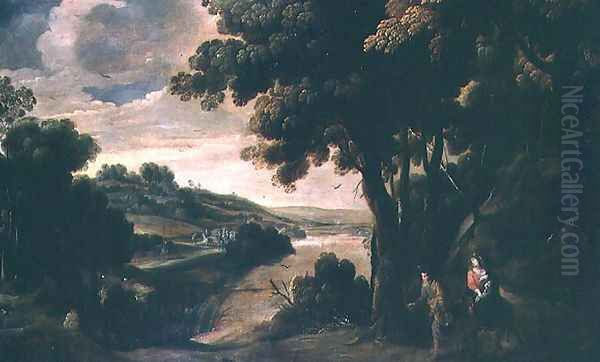Francisco Collantes (1599-1656) stands as a significant, if somewhat enigmatic, figure in the rich tapestry of Spanish Baroque art. Born and active primarily in Madrid, Collantes carved a distinct niche for himself as a painter of evocative landscapes and dramatic biblical scenes, a specialization less common in Spain compared to its prevalence in Italy or the Low Countries during the 17th century. His work, characterized by a unique synthesis of influences, contributed to the visual culture of Spain's Golden Age, leaving behind a legacy of powerful and atmospheric canvases.
Early Life and Formative Influences
Details regarding Francisco Collantes's early life and artistic training remain relatively scarce, a common challenge when studying artists of this period whose fame did not reach the towering heights of contemporaries like Diego Velázquez. He was born in Madrid in 1599. While concrete documentation of his apprenticeship is limited, art historians often point to the potential, though unconfirmed, tutelage under Vicente Carducho (c. 1576-1638), an influential court painter of Italian origin who played a key role in introducing late Mannerist and early Baroque styles to Madrid. Carducho's workshop was a prominent training ground, and his emphasis on drawing and composition could have provided a foundational basis for Collantes.
More definitively, Collantes's artistic development was profoundly shaped by the prevailing artistic currents of his time, particularly the robust naturalism and dramatic intensity emanating from Italy. The influence of Jusepe de Ribera (1591-1652), known as "Lo Spagnoletto," is palpable in Collantes's figure painting. Ribera, a Spaniard who spent most of his career in Naples (then under Spanish rule), was a master of tenebrism and unvarnished realism, often depicting saints and martyrs with raw emotional power. Collantes absorbed this approach, evident in the solid, often muscular, rendering of his figures and the expressive force they convey, particularly in his religious compositions.

Beyond Ribera, the broader Neapolitan School, itself a crucible of Caravaggesque naturalism and burgeoning Baroque dynamism, left its mark. Artists like Massimo Stanzione (1585-1656) and later Salvator Rosa (1615-1673), though Rosa was a younger contemporary, contributed to an environment where dramatic landscapes and expressive figures were highly valued. Collantes's connection to this milieu is also suggested by accounts from early biographers like Antonio Palomino, who mentioned that Collantes may have spent time studying in Rome and Naples, though definitive proof of such travels is elusive.
Furthermore, the legacy of 16th-century Venetian painting, with its emphasis on color, light, and atmospheric effects in landscape, resonated in Collantes's work. Masters like Titian (c. 1488/1490-1576) and Tintoretto (1518-1594) had pioneered the use of landscape not merely as a backdrop but as an integral, expressive component of their compositions. Collantes's sensitivity to mood, his rich, often earthy palettes, and his ability to create depth and atmosphere in his landscape vistas suggest an awareness and appreciation of these Venetian precedents.
The Artistic Landscape of Madrid
To fully appreciate Collantes's contribution, it's essential to consider the artistic environment of 17th-century Madrid. The city was the heart of a vast empire and a vibrant center for the arts, largely driven by royal and ecclesiastical patronage. The court of Philip IV was a magnet for talent. Diego Velázquez (1599-1660), Collantes's exact contemporary, dominated the scene as the leading court painter, revolutionizing portraiture and history painting with his unparalleled skill and psychological insight.
While figure painting, particularly religious subjects and portraiture, held a preeminent position in the hierarchy of genres in Spain, landscape painting was gradually gaining appreciation. Flemish artists like Jan Brueghel the Elder (1568-1625) and Paul Bril (1554-1626) had popularized landscape as an independent genre across Europe, and their works, or works influenced by them, were known in Spain through collections and prints. Italianate classical landscapes, epitomized by artists working in Rome such as Claude Lorrain (1600-1682) and Nicolas Poussin (1594-1664), also began to exert influence, promoting idealized and structured visions of nature.
Collantes operated within this context, distinguishing himself by focusing more intently on landscape than many of his Spanish peers. While artists like Francisco de Zurbarán (1598-1664) and Bartolomé Esteban Murillo (1617-1682) occasionally incorporated landscape elements into their predominantly religious works, Collantes often gave landscape a co-starring, if not leading, role. His approach was less about the meticulously detailed observation of the Flemish school or the serene classicism of Claude, and more about imbuing his landscapes with a sense of drama, history, and sometimes, a wild, untamed quality.
Development of a Distinctive Style

Francisco Collantes forged a distinctive artistic voice by synthesizing these diverse influences—Ribera's naturalism, Neapolitan drama, Venetian color, and emerging European landscape traditions—into a coherent and personal style. His works are often characterized by their grandeur and a sense of dynamic energy. He favored expansive vistas, frequently incorporating dramatic natural formations, ancient ruins, castles, and turbulent skies, which lent his scenes a romantic and often melancholic atmosphere.
His landscapes are rarely empty stages; they are almost always populated, typically with figures enacting biblical or, less frequently, mythological narratives. These figures, though sometimes small in scale relative to the vastness of their surroundings, are crucial to the meaning and emotional impact of the paintings. They are rendered with a solidity and expressiveness that, as noted, owes much to Ribera. There's a tangible quality to his figures, a sense of weight and presence, even when they are dwarfed by the immensity of nature or architecture.
Collantes's handling of paint is robust, with a visible brushwork that contributes to the vitality of his surfaces. His palette often leans towards rich, earthy tones—browns, ochres, deep greens—punctuated by more vibrant hues in the figures' drapery or in specific landscape elements. He was adept at using light and shadow (chiaroscuro) not just to model forms but also to create dramatic emphasis and guide the viewer's eye through the composition. This interplay of light could illuminate a key narrative moment or cast parts of the landscape into evocative mystery.
A recurring motif in his work is the inclusion of architectural ruins or ancient structures. These elements were not merely picturesque additions; they often carried symbolic weight, alluding to the passage of time, the transience of human endeavors, or the historical settings of the narratives depicted. This interest in ruins aligns with a broader Baroque fascination with antiquity and the picturesque decay of classical civilizations.
Key Themes and Representative Works
Collantes's oeuvre is dominated by biblical subjects set within expansive landscapes. These scenes allowed him to combine his skill in figure painting with his passion for depicting the natural world, often charged with divine significance.

One of his most celebrated and powerful works is The Vision of Ezekiel: The Resurrection of the Flesh (c. 1630s), now housed in the Museo Nacional del Prado, Madrid. This painting exemplifies his mature style. The lower half of the canvas is a dramatic, almost macabre, depiction of skeletal remains coming back to life, as described in the Book of Ezekiel. The figures are rendered with an anatomical understanding and a dramatic intensity that is truly arresting. Above this scene of resurrection, a vast and somewhat turbulent landscape unfolds, with craggy mountains and a dynamic sky, creating a powerful backdrop for the divine miracle. The sheer ambition and complex composition of this work highlight Collantes's mastery. This painting was significant enough to have been taken to Paris in 1811, intended for Napoleon's museum.
Another important work, also in the Prado, is Saint Arnulf (or Saint Arnulph). While the specific iconography might relate to one of several saints named Arnulf, the painting typically showcases Collantes's ability to integrate a solitary, contemplative figure within a richly detailed and atmospheric landscape. Such paintings often emphasize themes of hermitage, spiritual retreat, and the divine presence in nature.
The Burning Bush (or The Burning Palm Tree, c. 1634), with a version in the Louvre Museum, Paris, depicts the Old Testament scene where God appears to Moses in a bush that burns but is not consumed. Collantes uses the landscape setting—often rugged and remote—to enhance the miraculous and awe-inspiring nature of the event. The play of supernatural light from the bush against the natural landscape is a hallmark of his approach to such theophanies.
Other notable works include:
Agar and Ishmael, located in the Museum of Art, Rhode Island School of Design, which portrays the poignant biblical story of Hagar and her son Ishmael abandoned in the wilderness. The desolation of the landscape would underscore their plight.
The Burning of Troy (sometimes referred to via mistranslation as The Dripping of Troy), with a version in the Prado, allowed Collantes to explore a classical theme filled with drama, architectural destruction, and human suffering, all set against a fiery, chaotic backdrop.
The Repentance of Saint Peter, a theme popular in Counter-Reformation art, would have given Collantes the opportunity to depict intense emotion, likely set in a somber, evocative landscape that mirrors Peter's remorse. Ribera also famously painted this subject, and Collantes's versions would show his engagement with Ribera's powerful naturalism.
Saint Paul the Hermit, another subject favored for its combination of ascetic spirituality and a wild, natural setting, similar in thematic content to depictions of Saint Jerome or Saint Anthony Abbot in the wilderness.
These works demonstrate Collantes's consistent ability to fuse narrative, emotion, and landscape into compelling visual statements. His figures are not merely staffage; they are integral to the story, and the landscape itself often acts as a character, reflecting or amplifying the mood of the scene.
Patronage, Reputation, and Later Career

Francisco Collantes achieved considerable prestige during his lifetime. His paintings were sought after for important decorative projects, most notably for the Palacio del Buen Retiro in Madrid. This sprawling palace complex, built for Philip IV, was adorned with an extensive program of paintings by leading artists of the day, both Spanish and international. Collantes's contributions to the Buen Retiro, likely a series of landscapes, underscore his standing in the Madrid art world. The inclusion of his works alongside those of artists like Claude Lorrain, Nicolas Poussin, Jan Both, and Herman van Swanevelt in the palace's landscape commissions indicates the high regard for his abilities in this genre.
His paintings also appeared in the inventories of prominent 17th-century Madrid collectors, further attesting to his contemporary reputation. Despite this success, detailed records of his commissions or specific patrons, beyond the Buen Retiro, are not abundant.
The primary contemporary accounts of Collantes's life come from Antonio Palomino (1655-1726) in his "El Parnaso español pintoresco laureado" (The Pictorial Spanish Parnassus Laureate) and from the earlier notes of Lázaro Díaz del Valle (1606-1669). Palomino, writing some decades after Collantes's death, described him as a specialist in landscapes with small figures, noting his skill and the esteem in which his works were held. He mentions Collantes's death in Madrid in 1656 and refers to him as having been "recently deceased" in a note dated around 1657 by Díaz del Valle. Some sources also suggest that Collantes may have occasionally painted portraits, though landscapes and biblical scenes clearly formed the core of his output.
The Spanish Context of Landscape Painting
Collantes's dedication to landscape painting was somewhat exceptional in the Spanish context of his time. While Italian artists like Annibale Carracci (1560-1609) and Domenichino (1581-1641) were developing the ideal classical landscape in Rome, and Flemish and Dutch painters like Peter Paul Rubens (1577-1640), Jacob van Ruisdael (c. 1629-1682), and Meindert Hobbema (1638-1709) were elevating landscape to unprecedented heights of naturalism and expressiveness in Northern Europe, Spain did not have as strong an indigenous tradition of independent landscape painting.
The Spanish temperament in art often leaned towards profound religious expression, stark realism in portraiture, and dramatic narrative. When landscapes appeared, they were usually subservient to these primary concerns. Velázquez himself painted two extraordinary, small landscapes at the Villa Medici in Rome, but these were more private studies than public statements in the genre. El Greco (1541-1614) had earlier produced the visionary View of Toledo, but this was an exceptional piece.
Collantes, therefore, stands out. His landscapes, while often serving biblical narratives, possess an intrinsic interest and power that suggest a genuine passion for the genre itself. He can be seen as a bridge, absorbing international trends, particularly from Italy, and adapting them to a Spanish sensibility. His contemporary, Antonio Pereda (1611-1678), known more for his vanitas still lifes and religious paintings, also produced some works with notable landscape elements, and their styles sometimes show affinities, reflecting a shared Madrid artistic environment.
Legacy and Art Historical Significance
Francisco Collantes died in Madrid in 1656. Despite the relative scarcity of biographical information, his artistic legacy is secure. He is recognized as one of the foremost Spanish Baroque painters to specialize in landscape, bringing a distinctive dramatic and narrative intensity to the genre. His ability to integrate expressive figures with atmospheric and often monumental natural settings set him apart.
His influence on subsequent Spanish landscape painting is perhaps not as direct or easily traceable as that of some other European masters in their respective regions, partly because landscape painting in Spain only gained fuller autonomy later. However, his works remained in significant collections, including the royal collections, ensuring their visibility.
Today, Francisco Collantes is appreciated for his unique synthesis of Spanish realism and Italianate landscape traditions. His paintings offer a powerful vision of nature, often imbued with spiritual or historical resonance. They stand as a testament to the diversity of artistic expression within the Spanish Golden Age, reminding us that beyond the towering figures of Velázquez, Zurbarán, and Murillo, artists like Collantes made vital contributions to the richness of Baroque art. His works continue to engage viewers with their dramatic compositions, their evocative atmospheres, and their skillful storytelling, securing his place as a master of the Spanish Baroque landscape.